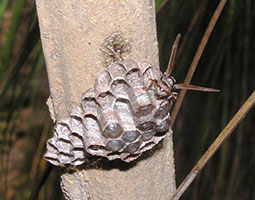Ropalidia revolutionalis
Description

There are about 35 different paper wasp species native to Australia, ranging from 8 to 26 mm in length and patterned in yellow, brown, black, often with a banded abdomen. Paper wasps have a small head, with medium sized eyes and medium length antennae. The body is slender, with a very narrow waist (petiole). Paper wasps are unusual in having their front pairs of wings folded lengthwise when they are not in use.
Some paper wasps form small colonies, and make paper nests under tree branches and the eaves of houses. The nests are constructed from wood fibre mixed with saliva. Their nests vary according to the individual species, which is a method used by entomologists in identification.
The wasp larvae are maggot-like and develop inside the papery cells of the nest.
Paper wasps can deliver painful stings, but are not as aggressive as introduced European Wasps. They normally only attack humans if their nest is disturbed. If stings are multiple, a more severe systemic reaction may occur.
Adaptations
- Paper wasps live in large colonies that work together to collect food and defend developing larvae
Feeding relationships
- What I eat: as a larvae — caterpillars, as an adult - nectar
- What eats me: frogs, toads, lizards, birds (e.qg. starlings, blackbirds, magpies)
Interesting facts
The female wasp is always busy. If she's tapping her way along a leaf, she's probably looking for a caterpillar to feed her larvae. If she's fossicking on an old fence paling, chances are she's scraping up wood fibres to make a nest. If she's busy in a flower, she's feeding on nectar. The great majority of Australian native wasp species don't live in colonies and are solitary, nesting in the ground or in cracks or crevices and they don't attack humans.